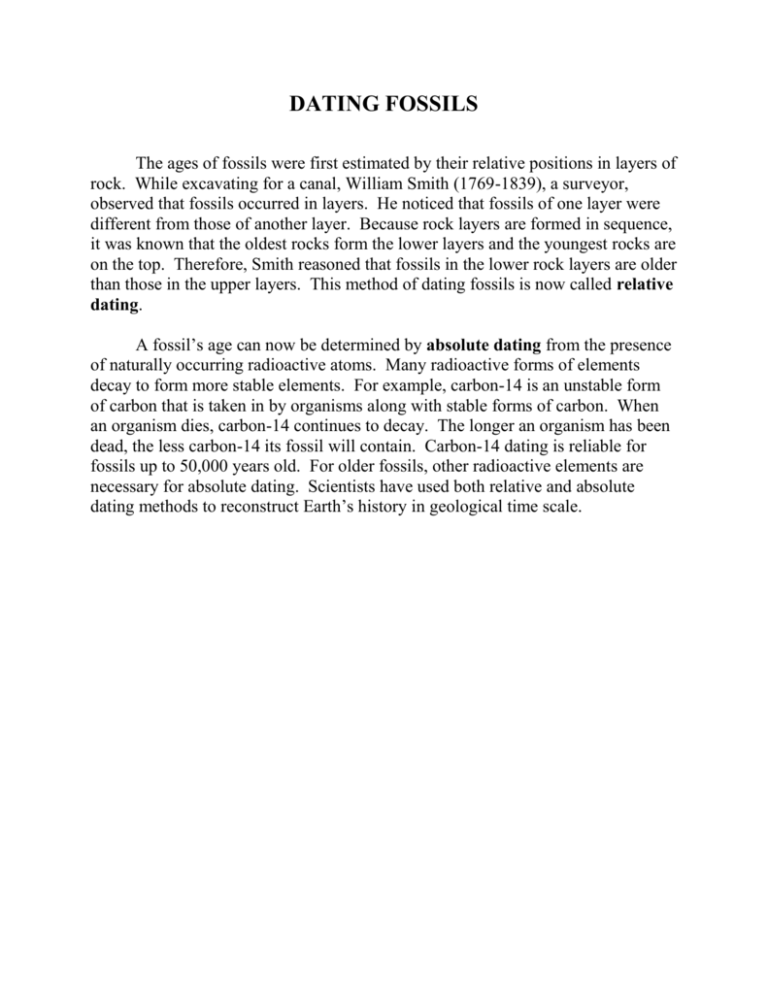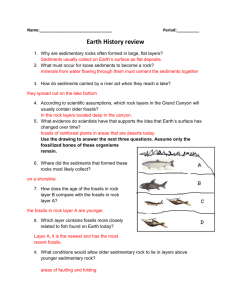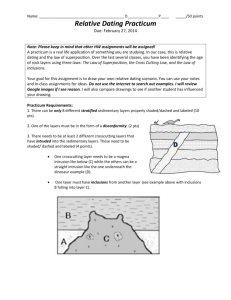DATING FOSSILS
advertisement

DATING FOSSILS The ages of fossils were first estimated by their relative positions in layers of rock. While excavating for a canal, William Smith (1769-1839), a surveyor, observed that fossils occurred in layers. He noticed that fossils of one layer were different from those of another layer. Because rock layers are formed in sequence, it was known that the oldest rocks form the lower layers and the youngest rocks are on the top. Therefore, Smith reasoned that fossils in the lower rock layers are older than those in the upper layers. This method of dating fossils is now called relative dating. A fossil’s age can now be determined by absolute dating from the presence of naturally occurring radioactive atoms. Many radioactive forms of elements decay to form more stable elements. For example, carbon-14 is an unstable form of carbon that is taken in by organisms along with stable forms of carbon. When an organism dies, carbon-14 continues to decay. The longer an organism has been dead, the less carbon-14 its fossil will contain. Carbon-14 dating is reliable for fossils up to 50,000 years old. For older fossils, other radioactive elements are necessary for absolute dating. Scientists have used both relative and absolute dating methods to reconstruct Earth’s history in geological time scale. FOSSILS: EVIDENCE OF EVOLUTION FOSSILS HAVE BEEN FORMED IN MANY DIFFERENT WAYS A fossil is the actual remains or any trace of an organism that lived sometime in the past. The study of fossils provided the first, and still provides the strongest, evidence of evolution. Fossils have been formed in many different ways. Listed below are most of the ways fossils are formed: Carbonaceous film – thin film of carbon atoms left behind Preservation in amber (hardened tree resin) Preservation in ice (ex., 25,000 year old remains of woolly mammoths) Preserved hard parts (ex. dinosaur bones) Petrification – process in which the remains of the organisms are turned to stone (examples: stone replicas of original bones and petrified forests) Molds – the shapes of organisms preserved in hardened sand or mud Casts – molds which have become filled with minerals and turned to rock Imprints – impressions made by living things in mud which hardens to rock (examples: dinosaur footprints and leaves) Other traces, including hardened burrows Preservation in tar MOST FOSSILS ARE FOUND IN SEDIMENTARY ROCKS Most fossils form when organisms and traces of organisms are rapidly buried in fine sediments (rock particles) deposited by water, wind, or volcanic eruptions. Thus, the environments that are most conducive to fossil formation are wet lowlands, slow-moving streams, lakes, shallow seas, and areas near volcanoes that spew out volcanic ash. The chances that organisms living in upland forests, mountains, grasslands, or deserts will form fossils after they die are slim because their bodies will decay or be eaten and scattered by scavengers before any sediment can bury them. RELATIVE DATING Whenever layers of sedimentary rock are exposed to view, they present a record of events that occurred during a certain time interval. If the rock layers are still in the original order of deposit, the lower layers were deposited earlier than the upper layers. Fossils in the lower layers represent organisms that lived at an earlier time that the fossils in upper layers. From this, the relative time of appearance and disappearance of organisms can e determined. Any method involving the comparison of rock layers to determine the order in which events occurred is called relative dating. ABSOLUTE DATING Besides dating based on rock layers (relative dating), there are more accurate methods for determining the Earth’s history. These methods are referred to as absolute dating methods. The most accurate and reliable absolute dating method is radioactive dating. This method can determine the actual age of rocks and fossils. It is based on the fact that certain elements have unstable atoms, and all things contain some unstable atoms. What happens to unstable atoms is that their nuclei break down or decay. As the nuclei break down, the unstable atoms change to atoms of a different element (for example, uranium-238 decays to lead). During this process, called radioactive decay, energy is given off in the form of radiation. The property of emitting radiation is known as radioactivity. The rate at which a radioactive form of an element decays is fixed and unchangeable. The time required for half the radioactive atoms of a sample of an element to decay is called the half-life of that element. Each radioactive form of an element has its own unique half-life In radioactive dating, paleontologists use their knowledge of half-lives to date fossils. Specifically, for some element found in their rock or fossil, they count the number of half-lives that have gone by. They use a chart similar to the one below to help them date their fossil. IF SAMPLE HAS ½ OF ITS ORIGINAL AMOUNT OF RADIOACTIVE ATOMS OF SOME PARTICULAR ELEMENT. . . . . . THEN 1 HALF-LIFE HAS GONE BY. IF ¼ OF ORIGINAL RADIOACTIVITY. . . . . . . . . . . THEN 2 HALF-LIVES HAVE GONE BY. IF 1/8 OF ORIGINAL RADIOACTIVITY. . . . . . . . . . . THEN 3 HALF-LIVES HAVE GONE BY IF 1/16 OF ORIGINAL RADIOACTIVITY. . . . . . . . . THEN 4 HALF-LIVES HAVE GONE BY. Radioactive dating methods cannot be applied to sedimentary rocks. The types of rock they can be used on are igneous rocks – rocks that formed when molten materials in the Earth’s crust cooled and hardened. However, the absolute age of sedimentary rocks can often be estimated by age of igneous rocks that formed above, below, or within the sedimentary layers.









